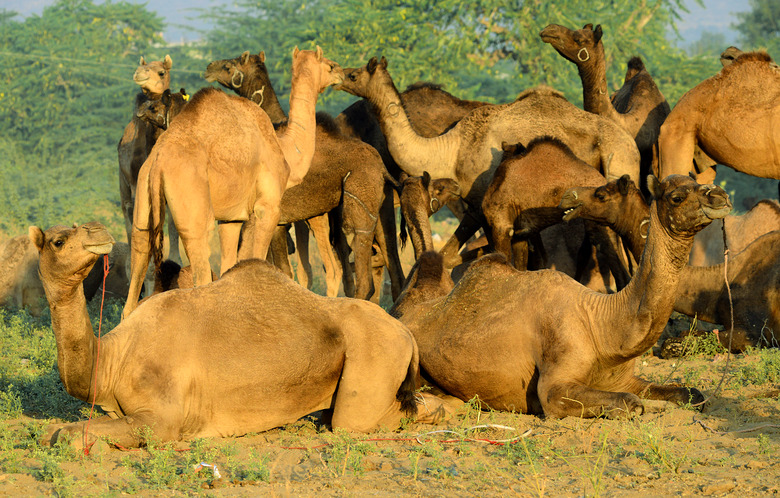Middle Eastern Desert Animals
The Middle East is home to two major deserts which host an array of animal species able to survive the extreme climate and landscapes. Though biodiversity is relatively scarce in these deserts compared to other types of environments, and human activity has destroyed parts of the habitat, several types of mammals and reptiles continue to make their home there.
Types
Types
Middle Eastern deserts are home to a host of animals, including gazelles, sand cats, oryx (an antelope species), lizards, camels, cattle and goats. The majority of these animals, including sand cats, gazelles, lizards and oryx, are wild and survive without human contact. On the other hand, cattle, camels and goats are herded through the deserts by nomadic tribes who guide their flocks to the sparse grazing lands of the region.
Geography
Geography
Middle Eastern desert animals inhabit two main deserts: the Arabian Desert and the Syrian Desert. The former stretches from Iraq and Jordan to Oman and from the Persian Gulf to Yemen, while the latter reaches across the northern Arabian Peninsula, including parts of Syria, Saudi Arabia, Jordan and Iraq.
Climate
Climate
The animals living in both the Arabian and Syrian Deserts are adapted to the extreme environmental conditions. In the latter, there is no arable land available for the animals, as rainfall is extremely scarce throughout the year. While temperatures frequently reach over 100 degrees F during the day, nighttime brings freezing temperatures throughout autumn and winter. For this reason, most desert species find cover either underground, among sand dunes or among shrubbery during the night.
Size
Size
The Arabian Desert is a large expanse of land–900,000 square miles–and has as its center the Rub' al-Khali, one of the world's biggest continuous sand masses. The smaller Syrian Desert consists of about 200,000 square miles, and has fewer animal species than the Arabian Desert.
Considerations
Considerations
Desert species in the Middle East are menaced by a number of man-made threats to their ecosystem, which have already begun to encroach on their habitats as well as their food and water supplies. A few of these threats include over-grazed land by the cattle and goats herded by nomadic tribes, oil and gas pipeline construction, oil spills, vehicle off-roading and the impacts of wars. Many desert species in the region have already become extinct due to hunting and habitat degradation. These now-extinct animals include the striped hyena, honey badger and jackal. Meanwhile, other types of animals, such as the sand gazelle, have been re-introduced to Middle Eastern desert preserves, where they are now protected.
References
Cite This Article
MLA
Dixon, Laura. "Middle Eastern Desert Animals" sciencing.com, https://www.sciencing.com/middle-eastern-desert-animals-5164483/. 22 November 2019.
APA
Dixon, Laura. (2019, November 22). Middle Eastern Desert Animals. sciencing.com. Retrieved from https://www.sciencing.com/middle-eastern-desert-animals-5164483/
Chicago
Dixon, Laura. Middle Eastern Desert Animals last modified March 24, 2022. https://www.sciencing.com/middle-eastern-desert-animals-5164483/
